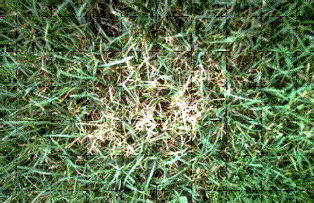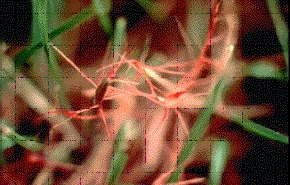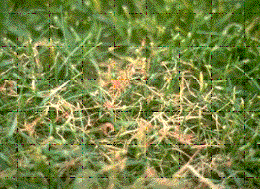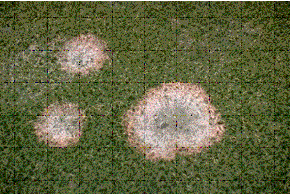RED THREAD
Red thread is caused by the fungus Laetisaria fuciformis
(formerly called Corticium fuciforme). In Illinois, this
disease is of chief concern when it attacks the grass blades and
leaf sheaths of fine-leaf fescues (red and chewings), Kentucky and
annual bluegrasses, perennial ryegrass, and bentgrasses during cool,
damp weather in the spring and fall. Fine-leaved fescues and perennial
ryegrasses are very susceptible. Velvet bentgrass cultivars are
more susceptible than colonial and creeping bents. Other grasses
that are sus- ceptible include bermudagrass, redtop, sheep fescue,
tall fescue, hard fescue, velvetgrass, zoysiagrasses, and quackgrass.
Although red thread rarely kills turfgrass plants outright, it does
weaken them and contributes to their decline and death from subsequent
stress diseases.
Red thread is an important disease, especially on slow-growing,
nitrogen-deficient turf in the cooler and more humid areas of the
Northeast, Pacific Northwest, and in the Midwest during excessively
moist weather in the spring and autumn. Red thread has even been
found growing under the snow. The disease is favored by slow-growing,
nitrogen-deficient turfgrass, excess thatch, low calcium levels
in the soil, water stress, a sudden drop in temperature, misused
herbicides, and exhibits weakening from attack by other pathogens.
|

Figure
1.
Red thread infecting South Dakota Common Kentucky bluegrass. Note
the fungus mycelia binding the leaf blades together.

Figure
2.
Close-up of the branched gelatinous masses of the red thread fungus.
The mycelial mats harden and become blood-red "threads"
(courtesy of R.W. Smiley).
|
Symptoms
The Laetisaria fungus forms conspicuous, pale to bright coral pink,
orange, or red mycelial masses on the grass blades and leaf sheaths.
In moisture-saturated air, the gelatinous mycelial masses may completely
cover the leaves, being bound by a delicate pinkish web of mycelia
that also mats the blades and leaf sheaths together (Figure 1).
The gelatinous masses, usually 1/16 to 1/4 inch long, are formed
by strands of branched hyphae. They often protrude from the tips
of grass blades and leaf sheaths as pointed and sometimes as branched,
antler-like appendages (Figure 2). The bright coral-pink to blood-red
mycelial mats harden and become threadlike (red threads) and brittle
when they dry, and function as sclerotia.
Initially, small patches of infected blades and leaf sheaths appear
to be partially or completely water-soaked. They shrivel and die
rapidly and fade to a bleached tan when dry. Death usually progresses
from the leaf tip downward. Where infection is severe, diseased
turf is bleached tan, yellowed, or "scorched" in roughly
circular- to irregular-shaped patches, varying from an inch to more
than 1 feet in diameter. Dead leaves are generally interspersed
with apparently healthy leaves, giving diseased turf a scorched
and ragged appearance (Figure 3). The spots may be scattered within
a turf area, or a number of patches may merge to form large, irregular
areas of blighted turfgrass with a reddish-brown or tan cast. Only
the leaves and sheaths are infected.
|

Figure
3.
Red thread in red fescue turf (courtesy of D.H. Scott).
|
Disease Cycle
The Laetisaria fungus survives from season to season as threads
of dried, dormant mycelium on the leaves and in the debris of previously
infected plants. The fungus is disseminated to healthy turf areas by bits
of red threads and microscopic spores (arthroconidia and basidiospores)
and as dormant mycelium in infected leaf tissue. Spreading occurs by splashing
or flowing water and by wind, shoes, mowers, and other turfgrass equipment.
Infection and disease development are favored by air temperatures of 60
to 75 F (15 to 24 C) coupled with prolonged periods of overcast weather,
light rains, heavy dews, fog, and moisture-saturated air. The red threads
and dormant mycelia resume growth, and hyphae penetrate unwounded leaves
through stomates or cut tips when free moisture exists on leaf surfaces
and the proper temperature becomes suitable for disease development. The
infection quickly spreads throughout the leaf tissues. Water-soaked leaf
spots are evident 24 to 48 hours after penetration has taken place. The
pinkish mycelial masses can be seen within another day or two. The fungus
may be spread rapidly from plant to plant by cobwebby, pinkish mycelial
growth from the gelatinous masses on infected leaves.
Growth and disease development essentially stop below 33 and above 86
F (1 to 30 C). However, the causal fungus can survive extremes in temperature.
Mycelial growth in infected leaves or from mycelial mats continues when
conditions are again favorable.
Back to Top
Control
Cultural Practices
1. Maintain adequate and balanced soil fertility, based on soil test
reports and the recommended turfgrass-fertilization program for your area
and the grasses grown there. Red thread is most severe where potassium,
phosphorus, calcium, and especially nitrogen are deficient. Avoid overstimulation
from fertilizer, particularly fertilizer with a water-soluble, high-nitrogen
source.
2. Where red thread has been a problem in the past, maintain a soil reaction
(pH) between 6.5 and 7.0. Test the soil pH, and treat the soil accordingly
if practical.
3. Increase light penetration, air movement, and rapid drying of the
grass surface by pruning or selectively removing dense trees and shrubs
that border the turf. When landscaping, space plantings properly to avoid
excess shade and allow for adequate air movement.
4. Avoid overwatering and frequent sprinkling in the late afternoon or
evening. During summer or early fall drought periods, water established
turf thoroughly early in the day so that the grass surface can dry before
night. Water infrequently and deeply, moistening the soil at each watering
to a depth of 6 inches or more.
5. Provide for good soil drainage when establishing a new turfgrass area.
6. Remove excess thatch, preferably in late summer or early fall, when
it accumulates to 1/2 inch. Use a "vertical mower", "power
rake", or similar equipment. This equipment can be rented at many
large garden supply or tool rental stores.
7. Mow frequently at the height recommended for the area and for the
grasses grown there. Mow upright grasses, such as Kentucky bluegrass,
ryegrasses, and fescues, at 1½ to 2 inches in spring and fall;
2½ to 3 inches in the summer. Creeping grasses, such as bentgrass
and bermudagrass, may be mowed to 1/2 inch or less. Remove no more than
one-fourth to one-third of the leaf surface at one cutting.
8. Collect the clippings during periods when the grass is growing slowly
and the disease is active. This may reduce the number of red threads that
eventually fall back into the turf.
9. Improved perennial ryegrasses reported as being resistant to red thread
include Birdie II, Citation II, Linn, Pennant, Pippin, Premier, and Tara.
Blazer, Caprice, Manhattan, Ovation, and NK-200 are very susceptible.
The following perennial ryegrasses lie somewhere in between: Acclaim,
All-Star, Barry, Birdie, Cittion, Cupido, Cowboy, Cockade, Dasher, Delray,
Derby, Diplomat, Eaton, Elda, Ensporta, Epic, Fiesta, Game, Manhattan
II, Omega, Palmer, Pelo, Prelude, Ranger, Regal, Repell, Yorktown, and
Yorktown II.
Some fine-leaf fescue cultivars that are resistant or moderately resistant
to red thread include Atlanta, Aurora, Bighorn, Biljart, Dawson, Epsom,
Flyer, Golfrood, Reliant, Scaldis, Shadow, Spartan, Valda, Waldina, Weekend,
and Wintergreen. Susceptible fine-leaf fescues are Boreal, Ceres, Commodore,
Ensylva, and Ruby. Hard fescues are often overseeded where red thread
is a serious problem.
Somewhat resistant Kentucky bluegrass cultivars resistant to red thread
and other diseases are listed in Table 1. Other resistant
Kentucky bluegrasses include Adelphi, Admiral, Aspen, Banff, Barblue,
Bonnieblue, Bono, Bristol, Classic, Dormie, Eclipse, Haga, Harmony, Holiday,
Merit, Midnight, Mona, Mosa, Nassau, Ram I, Trenton, and Welcome. Susceptible
Kentucky bluegrasses include Apart, Argyle, A-34 or Bensun, Glade, Kenblue,
Mystic, South Dakota common or certified, and Sydsport.
Fungicide Applications
Where red thread has been troublesome, apply a suggested fungicide at
7- to 21-day intervals during moist weather in the spring and fall, when
daytime temperatures average between 65 and 75 F (18 to 24 C). Begin spray
applications when the disease is first evident. For the most effective
control, uniformly spray 1,000 square feet of turf with 5 to 10 gallons
of water that contain only one of the fungicides listed for red thread
in the current edition of Illinois Homeowner's Guide to Pest Management.
Back to Top
PINK PATCH
Pink patch, formerly thought to be a form of red thread and caused by
the fungus Limonomyces roseipellis, is a minor disease of frequently
mowed grass. Apparently, the disease is restricted to perennial rygrass,
Kentucky bluegrass, creeping red and chewings fescues, creeping bentgrass,
bermudagrass, and zoysiagrass. Pink patch is much more severe on either
unmowed or infrequently mowed grasses that are grown under low nitrogen
fertilization than it is on highly maintained turfgrasses.
Symptoms
Although patches generally remain green, diseased turf may have
a tannish cast. Affected areas are irregularly shaped in coarse-textured
turf, but distinct pinkish patches, two to six inches across, occur
in creeping bentgrass (Figure 4). The disease occurs in spring and
autumn during prolonged periods of heavy dews, light rains, and
fog on turfs with inadequate nitrogen fertility. Small, irregularly-shaped
areas of turf become covered with a pink to reddish film of mycelium
that tends to form first along the leaf margins. Later, the entire
width of the leaf blade is covered. Only leaves and sheaths are
infected, and diseased leaves die from the tip downward.
There are three key diagnostic characteristics that are used to
separate pink patch and rd thread: the red threads and arthroconidia
are not produced by the pink patch fungus, and hyphae of the
Limonomyces fungus have clamp connections whereas the hyphae
of the red thread fungus do not.
|

Figure
4.
Pink patch infecting creeping bentgrass. Patches are two to six
inches across (courtesy P.H. Demoeden).
|
Disease Cycle
The disease cycle of pink patch is similar to that of red thread, except
for the absence of arthroconidia and red threads.
Control
Control measures are usually not necessary on mowed turfs. Mow frequently
at the recommended height of cut for the grass or grasses that are grown.
Fertilize on the basis of soil test recommendations, as outlined for the
control of red threads.
Table 1. Modern Kentucky Bluegrass Cultivars Adapted
to Illinois and Reported to be Moderately to Highly Resistant (R)a to
one or More Diseases
|
Kentucky Bluegrass Cultivars
|
"Helminthosporium"
diseases
|
Leaf Smuts
|
Leaf and stem rust
|
Summer patch & necrotic
ringspot
|
Sclerotinia dollar spot
|
Typhula blight
|
Septoria leaf spot
|
Red thread
|
|
A-20
|
R
|
R
|
R
|
R
|
R
|
|
(b)
|
R
|
|
A-34 (Bensun)
|
R
|
R
|
R
|
R
|
|
|
|
|
|
Adelphi
|
R
|
R
|
R
|
R
|
R
|
R
|
R
|
R
|
|
Baron
|
R
|
R
|
R
|
R
|
R
|
R
|
|
R
|
|
Bonnieblue
|
R
|
R
|
R
|
R
|
R
|
R
|
|
R
|
|
Brunswick
|
R
|
R
|
R
|
R
|
R
|
|
|
|
|
Cheri
|
R
|
R
|
R
|
R
|
R
|
|
R
|
|
|
Enmundi
|
R
|
|
R
|
R
|
R
|
|
|
R
|
|
Enoble
|
R
|
|
|
|
|
|
|
|
|
Fylking
|
R
|
R
|
R
|
|
|
|
R
|
|
|
Geronimo
|
R
|
|
|
|
R
|
|
|
R
|
|
Glade
|
|
R
|
R
|
R
|
|
R
|
|
|
|
Majestic
|
R
|
R
|
R
|
R
|
R
|
|
R
|
R
|
|
Monopoly
|
R
|
R
|
|
R
|
|
R
|
|
R
|
|
Nugget
|
R
|
R
|
R
|
|
|
R
|
R
|
R
|
|
Parade
|
R
|
R
|
R
|
R
|
R
|
|
R
|
|
|
Plush
|
R
|
R
|
R
|
|
R
|
|
|
R
|
|
Rugby
|
R
|
R
|
R
|
R
|
R
|
|
|
|
|
Sydsport
|
R
|
R
|
R
|
|
R
|
|
R
|
|
|
Touchdown
|
R
|
R
|
|
R
|
|
|
R
|
R
|
|
Vantage
|
|
R
|
|
R
|
R
|
|
|
|
|
Victa
|
R
|
R
|
R
|
R
|
|
|
|
R
|
a A resistant (R) rating does not mean that a particular cultivar will
be resistant in all locations every year. Due to the presence of physiological
races or strains of the various fungi that cause these diseases, a cultivar
may be susceptible in one locality and highly resistant in another. This
is especially true of powdery mildew and is the reason we omitted this
disease from our ratings.
b A blank under a given disease does not necessarily indicate susceptibility.
In some cases it means that no data are available on which to evaluate
the relative susceptibility or resistance to a particular disease.
Back to Top
|



